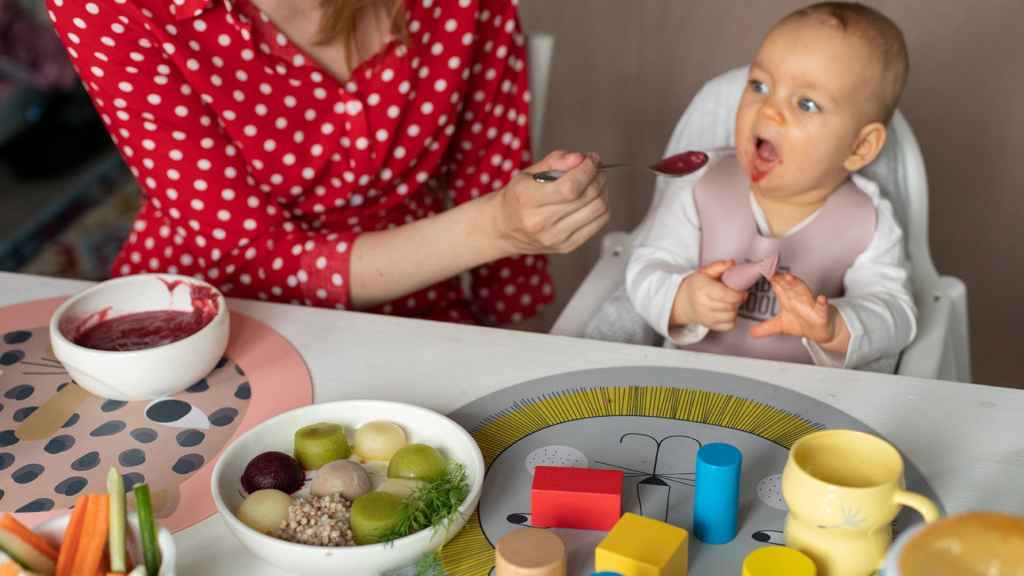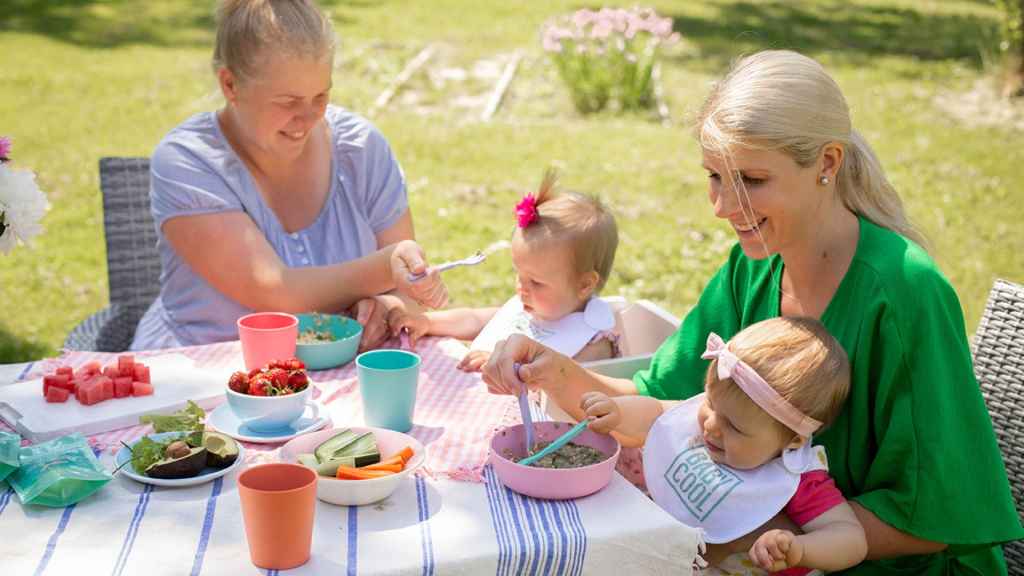Recommendations for starting on solid food
Start with one food and give it a few days for your baby to get used to before taking on the next. From then on, you can start mixing all the foods your child is already used to.
Your baby should be healthy when you start with extra food, and the meal should be given before lunchtime.
Quantities should start with one teaspoon for each new food on the first day and gradually increase that according to the child’s appetite – the child knows their own needs and won’t let themselves go hungry.
Offer the child a drink with the food. The best drink is water, practice drinking from a cup – it’s very difficult to get rid of the baby bottle later.
If your child is restless or has an upset stomach, temporarily skip all extra food and wait a few days until they feel better again.
Don’t use salt, sugar, or spices in baby food during the first year of their life.
Train your child to eat with a spoon and give them an extra spoon, so they can experiment on their own as well.
When to start giving extra food?
From 4-6 months: vegetable puree: pumpkin, zucchini, carrot, parsnip, potato, aubergine, cauliflower, broccoli, Jerusalem artichoke.
Starting with one food is important so that baby can get used to different tastes and digestion has time to get used to different foods. This will also make it easier to switch to regular food in the future, as the child is familiar with different tastes.
Once your child is accustomed to vegetables, only then can fruit and berry purees be introduced – for example when you start giving the baby porridge (apple, pear, blueberry, redcurrant, raspberry, lingonberry, plum, cherry).
From 6 months: meat (lamb, beef, rabbit, pork, turkey, and chicken) and porridge (wheat, rye, barley, oat, buckwheat, maize, millet, rice, but also locust beans, quinoa, spelt), pear-strawberry puree cubes, green beans, egg yolk, fish.
From 8 months: beets, turnip, celery (root).
From 9 months: liver, acidified dairy products (yogurt, kefir, sour cream, curd, cottage cheese, cheese) and vegetables (spinach).
From 12 months: egg whites and dairy products (heavy cream, milk). Remember that milk and juice are food, not drink. The best drink for a child is water.
Don’t be afraid to give your child lactose and gluten – just keep an eye on your child to make sure there’s no negative reactions. Give grain products one at a time – for example, start with oats and consume them for 5-7 days before taking a new grain sort. Changing food too quickly on the menu does not give the right overview, which is suitable for a child, which is not and does not create a habit of eating this sort of food. Always start with small amounts (a tablespoonful) and little by little increase the amount. Just like any other new flavour and / or ingredient.
Initially, to make the puree more liquid, add either boiled water or breast milk to dilute it. It’s better to steam the vegetables or boil them with a little liquid. Make the porridge more liquid as well, in the beginning you can use wholemeal flour or flakes. You can also grind the flakes smaller or grind the porridge with a hand mixer. Add a little unrefined vegetable oil or butter to both the puree and porridge because the child also needs vegetable and animal fats and this increases the nutritional value of the food. From 9 months on, cow’s milk (a little amount) can also be added to porridge. Both butter, oil, and meat are added to the puree just before giving it to the child.
Meat, liver, fish
A toddler should definitely eat meat because it has the necessary substances (for example, protein, amino acids, iron) that aren’t found in vegetarian diets. It is important to make sure that the meat is high quality and fresh. Always give organic meat to your child – it doesn’t contain residues of antibiotics or plant protection products. The meat should be that of a young animal – this is especially important in the case of the liver, as all toxins are deposited there. The liver is the cleanest in a young, free-range animal. However, the liver contains a lot of iron, as well as vitamin B, vitamin D, and plenty of vitamin A. Due to the high vitamin A content, it’s not recommended to eat it every day, only about a spoonful a week.
In the case of fish, use fish caught from local fish farms or clean inland waters when making puree. The Baltic Sea is too polluted, so fish caught from the sea are not suitable. Imported cooled fish may have been treated with preservatives.
You should give animal-based foods to your child at least one meal per day. A few days a week, you can replace the meat with fish, liver, or egg yolk and, for example, mix it with vegetable puree. Later, you can add finely ground rye or buckwheat to the vegetable-meat puree. Sausages and other processed meat products are not suitable for children. Red meat (veal) is not replaceable with chicken nor fish. All of them are important, and the food should be kept as diverse as possible.
Prefer organic
As the first year of life is an exceptionally fast period of growth and development for a child, it’s very important that the food is clean, varied and nutritional. Be sure to get organically grown ingredients. A young body has to put its energy into growing and developing, not fighting with pesticides and ohter additives.
Freezing is the best way to preserve food
Freezing and freeze-drying are the best way to preserve food. By keeping vegetables and fruits in a cellar, they lose significantly more of their nutritional value than in a freezer. Frozen or freeze-dryed food stays good for up to two years and allows you to consume local garden produce all year round. If purees are frozen in cubes or as freeze-dryed powder, you can choose a portion that is exactly the right size for the child to eat in one sitting. In addition, the various purees can be mixed together or added to other meals so that your child can meet their daily meat or vegetable needs. For example, you can add pumpkin and lamb puree to rice or buckwheat – this way you can feed solid food to a child who already has some teeth.
You can also add, for example, a carrot cube or powder to pasta or homemade sauce. A cube of pear, apple, apple-blueberry or pear-strawberry puree is a great addition to breakfast porridge – it cools the porridge and acts as a jam at the same time.



